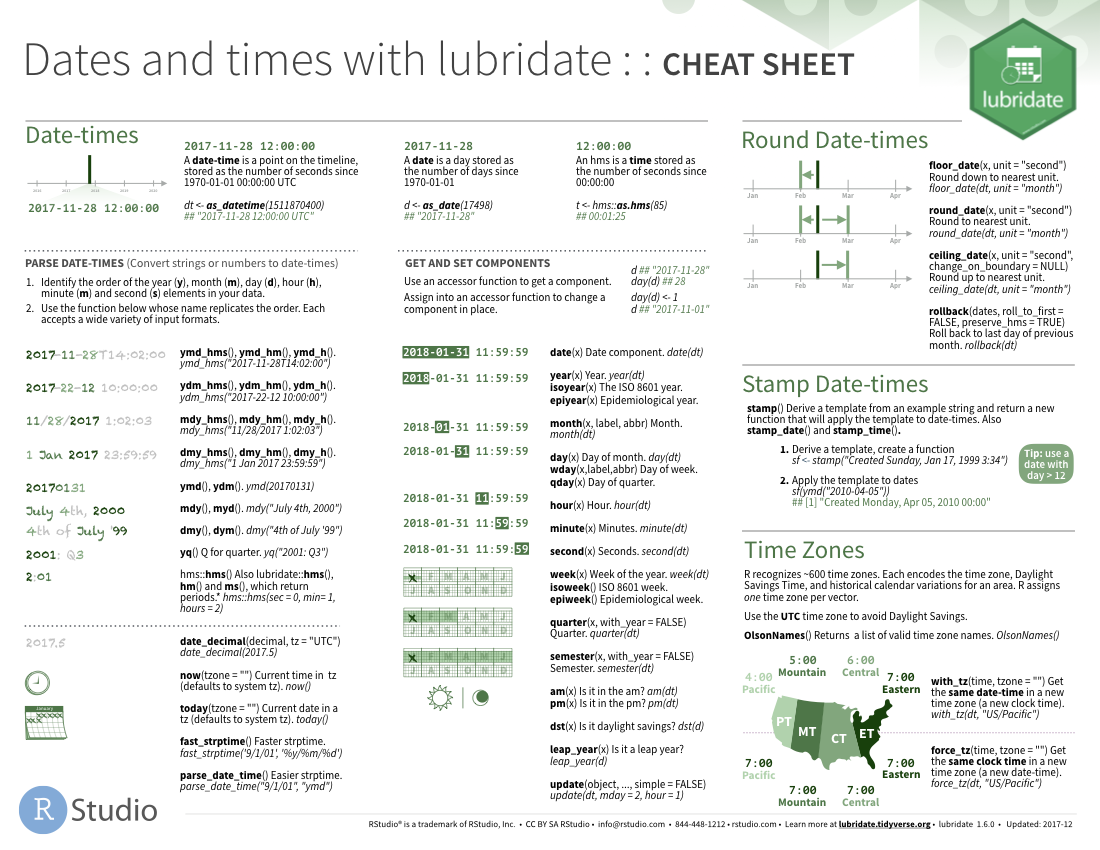- R Tidyverse Cheat Sheet Pdf
- R Tidyverse Cheat Sheet Printable
- R Tidyverse Cheat Sheet
- R Tidyverse Cheat Sheet Free
The goal of readr is to provide a fast and friendly way to read rectangular data (like csv, tsv, and fwf). It is designed to flexibly parse many types of data found in the wild, while still cleanly failing when data unexpectedly changes. Tidy Data - A foundation for wrangling in R Tidy data complements R’s vectorized operations. R will automatically preserve observations as you manipulate variables. No other format works as intuitively with R. M A F M. A. tidyr::gather(cases, 'year', 'n', 2:4) Gather columns into rows. Tidyr::unite(data, col., sep) Unite several columns. R uses factors to handle categorical variables, variables that have a fixed and known set of possible values. Factors are also helpful for reordering character vectors to improve display. The goal of the forcats package is to provide a suite of tools that solve common problems with factors, including changing the order of levels or the values. The Tidy Evaluation (Tidy Eval) is a framework for doing non-standard evaluation in R that makes it easier to program with tidyverse functions. Non-standard evaluation, better thought of as “delayed evaluation,” lets you capture a user’s R code to run later in a new environment or against a new data frame. Condition: Logical vector. True, false: Values to use for TRUE and FALSE values of condition.They must be either the same length as condition, or length 1.They must also be the same type: ifelse checks that they have the same type and same class. All other attributes are taken from true.

Getting started
tidyr functions fall into five main categories:
activate boricuaspuerto rican genealogy. “Pivotting” which converts between long and wide forms. tidyr 1.0.0 introduces
pivot_longer()andpivot_wider(), replacing the olderspread()andgather()functions. Seevignette('pivot')for more details.“Rectangling”, which turns deeply nested lists (as from JSON) into tidy tibbles. See
unnest_longer(),unnest_wider(),hoist(), andvignette('rectangle')for more details.Nesting converts grouped data to a form where each group becomes a single row containing a nested data frame, and unnesting does the opposite. See
nest(),unnest(), andvignette('nest')for more details.Splitting and combining character columns. Use
separate()andextract()to pull a single character column into multiple columns; useunite()to combine multiple columns into a single character column.Make implicit missing values explicit with
complete(); make explicit missing values implicit withdrop_na(); replace missing values with next/previous value withfill(), or a known value withreplace_na().
Usage

R Tidyverse Cheat Sheet Pdf
readr is part of the core tidyverse, so load it with:
To accurately read a rectangular dataset with readr you combine two pieces: a function that parses the overall file, and a column specification. The column specification describes how each column should be converted from a character vector to the most appropriate data type, and in most cases it’s not necessary because readr will guess it for you automatically.
R Tidyverse Cheat Sheet Printable

readr supports seven file formats with seven read_ functions:
read_csv(): comma separated (CSV) filesread_tsv(): tab separated filesread_delim(): general delimited filesread_fwf(): fixed width filesread_table(): tabular files where columns are separated by white-space.read_log(): web log files
Dmg extractor full version freetalkingrenew. In many cases, these functions will just work: you supply the path to a file and you get a tibble back. The following example loads a sample file bundled with readr:
Note that readr prints the column specification. This is useful because it allows you to check that the columns have been read in as you expect, and if they haven’t, you can easily copy and paste into a new call:
R Tidyverse Cheat Sheet

R Tidyverse Cheat Sheet Free
vignette('readr') gives more detail on how readr guesses the column types, how you can override the defaults, and provides some useful tools for debugging parsing problems.
